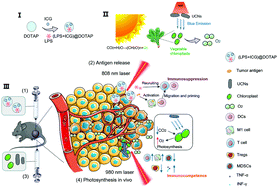NIR-triggered engineered photosynthetic micro–nanodevice for reversing the hypoxic tumor immunosuppressive microenvironment†
Abstract
Hypoxia is an important feature of the tumor microenvironment, which seriously affects the immunotherapy of tumors. Currently, the main method to improve the O2 concentration in the tumor microenvironment is to catalyze H2O2 around the tumor, whose concentration limits the production of O2. Herein, we designed an engineered photosynthetic micro–nanodevice composed of up-conversion nanorods (UCNs) and chloroplasts that simulated the photosynthesis of plants in nature and controlled the release of O2in vitro. The UCNs could transform near-infrared (NIR) light at 700–1000 nm with deep tissue penetration and biocompatibility into blue light, providing a light source for the engineered photosynthetic micro–nanodevice and ensuring the smooth operation and function of photosynthesis in vivo. The results indicated that the engineered photosynthetic micro–nanodevice could improve the hypoxic microenvironment of the tumor. The changes of the tumor microenvironment increased the content of immune cells, while they decreased the content of immunosuppressive cells around the tumor and improved the immunotherapeutic effect of the tumor, which provided a new approach for tumor treatment.



 Please wait while we load your content...
Please wait while we load your content...